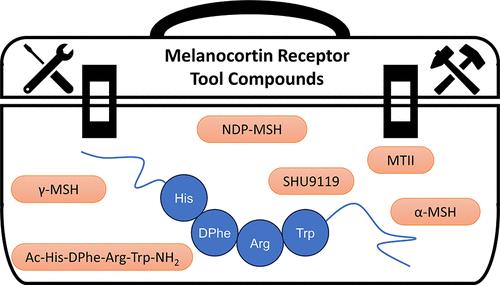Recommended Tool Compounds for the Melanocortin Receptor (MCR) G Protein-Coupled Receptors (GPCRs)
引用次数: 0
Abstract
The melanocortin receptors are a centrally and peripherally expressed family of Class A GPCRs with physiological roles, including pigmentation, steroidogenesis, energy homeostasis, and others yet to be fully characterized. There are five melanocortin receptor subtypes that, apart from the melanocortin-2 receptor (MC2R), are stimulated by a shared set of endogenous agonists. Until 2020, X-ray crystallographic and cryo-electron microscopic (cryo-EM) structures of these receptors were unavailable, and the investigation of their mechanisms of action and putative ligand–receptor interactions was driven by site-directed mutagenesis studies of the receptors and targeted structure–activity relationship (SAR) studies of the endogenous and derivative synthetic ligands. Synthetic derivatives of the endogenous agonist ligand α-MSH have evolved into a suite of powerful ligands such as NDP-MSH (melanotan I), melanotan II (MTII), and SHU9119. This suite of tool compounds now enables the study of the melanocortin receptors and serves as scaffolds for FDA-approved drugs, means of validating stably expressing melanocortin receptor cell lines, core ligands in assessing cryo-EM structures of active and inactive receptor complexes, and essential references for high-throughput discovery and mechanism of action studies. Herein, we review the history and significance of a finite set of these essential tool compounds and discuss how they are being utilized to further the field’s understanding of melanocortin receptor physiology and greater druggability.

黑色素皮质素受体 (MCR) G 蛋白偶联受体 (GPCR) 的推荐工具化合物
黑皮质素受体是一个在中心和外周表达的 A 类 GPCR 家族,其生理作用包括色素沉着、类固醇生成、能量平衡和其他尚未完全确定的作用。黑皮质素受体有五种亚型,除了黑皮质素-2 受体(MC2R)外,它们还受到一组共同的内源性激动剂的刺激。直到 2020 年,这些受体的 X 射线晶体学和低温电子显微镜(cryo-EM)结构仍无法获得,而对其作用机制和配体与受体之间假定相互作用的研究则是通过对受体进行定点突变研究以及对内源性配体和衍生合成配体进行有针对性的结构-活性关系(SAR)研究来推动的。内源性激动剂配体 α-MSH 的合成衍生物已发展成一套强大的配体,如 NDP-MSH(美拉罗坦 I)、美拉罗坦 II(MTII)和 SHU9119。目前,这一系列工具化合物可用于研究黑皮质素受体,并可作为 FDA 批准药物的支架、验证稳定表达黑皮质素受体细胞系的方法、评估活性和非活性受体复合物低温电子显微镜结构的核心配体,以及高通量发现和作用机制研究的重要参考。在此,我们将回顾这些重要工具化合物的历史和意义,并讨论如何利用它们来进一步加深本领域对黑色素皮质素受体生理学的理解,并提高其可药用性。
本文章由计算机程序翻译,如有差异,请以英文原文为准。
求助全文
约1分钟内获得全文
求助全文

 求助内容:
求助内容: 应助结果提醒方式:
应助结果提醒方式:


